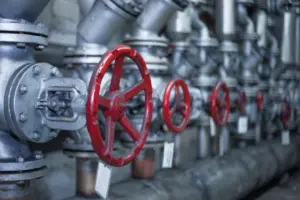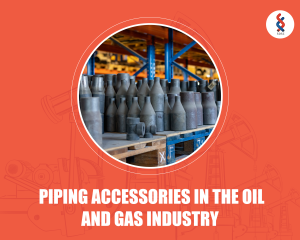Types of flanges and fitting used in oil and gas industry
A flange is a cast or forged steel product used to connect a pipe with another mechanical device. In the oil and gas industry, forged steel flanges are preferred due to their intrinsic strength and durability.
Fittings are units used to create reinforced connections, made with buttweld tees, pads, and saddles, from a run pipe to an outlet pipe, at 45 or 90 degrees. For the last few years industries have started using forged weldings on the pipes itself, to increase the reliability and connection strength. This type of forged fittings are otherwise called “branch connections”, or “branch fittings”, or “pipe branch outlet fittings”.Outlet fittings are forged products with high strength and clear cost advantages over conventional pipe branching techniques. Still outlet fittings are more available in the market.
Type of Flanges
- The nominal size ( the bore size of the flange, to match the bore size of the connecting pipe)
- The flange rating (designates the pressure and temperature performance of the flange)
- The schedule for welding neck flanges (that should match the pipe schedule)
While flanges are an integral part of the piping system but they are not as important as apparatus, pipes and valves, they are also cheaper than the mentioned equipments. We have multiple existing types but customization is always a possible option.Few types of flanges include the welding neck, blind, socket weld, lap joint, threaded, etc. There are also some special types of flanges, like the swivel flanges, the expander or reducer flanges, the Nipoflange or Weldoflange, and the orifice flanges.
Functions of different flanges
- For high pressure application and long lasting joints- welding neck, slip-on, and socket weld flanges are preferred.
- For lower pressure piping systems Threaded flanges are the choice to go, if vibrations are absent.
- Lap joint flanges are preferred for connecting the stub ends either to facilitate the alignment of the bolts of the two mating flanges or to reduce the cost of noble materials in high-grade flanged joints.
Material
Forged metals have more strength in contrast to cast metal, although advancing technologies are pushing cast in the same league as forged metals. Material’s quality preference comes in after considering cost in its entirety because if only the best materials are used for everything functioning of things would not have any impact but cost will rise by each nut and bolt.
So engineers try to have a balance between the material quality and cost. As of now the industry standard for the flanges are:
- ASTM/ASME/A/SA 105N (carbon steel flanges for high-temperature service)
- ASTM/ASME A/SA 350 LF2 CL 1/2 (CS flange for low temperature)
- ASTM/A694 F52(high yield carbon steel flange for line pipes)
- ASTM A182 F1 to F91 (alloy steel flange)
- ASTM/ASME A/SA 182 F304/L, F316/L(stainless steel flange)
- ASTM A182 F51, ASTM A182 F53/55 (duplex and super duplex flange)
- ASTM/ASME A/SA 516 Gr.60/65/70
- ANSI B 16.5 / 16.47 Ser.A (MSS SP-44)
- ANSI B 16.47 Ser. B, API 6A/6BX
- NACE MR-0175.
Types of Fittings
Similar to flanges, fittings can also be customised according to the equipment and apparatus. So the fittings type could be as many as you like. But they can be casted in few categories:
LR & SR Elbows, Equal Tees, Reducing Tees, Cross, Concentric & Eccentric Reducers, Caps, and Laterals.
They again follow the pattern of flanges, being differentiated by size and materials.
Function of fittings
As discussed above, the leading types of fittings are- LR & SR Elbows, Equal Tees, Reducing Tees, Concentric & Eccentric Reducers, Caps, and Laterals.
- LR & SR elbows (Long radius and short radius elbows)- are used to change the pathway of the pipeline.
- Reducing Tees, Concentric and Eccentric Reducers- are used to increase or decrease the pipe bore size.
[Reducing tees are also used to branch and reduce the pathway and bore size respectively.]
- Tees and Cross- are used to branch the pathway of the pipeline.
- Buttweld Caps- are used to blind the pipeline.
Material
Carbon steel buttweld fittings are most common in the oil and gas industry. While stainless steel is also used though it has more favours in other industries. The fittings have a common rule (as they are welded on the existing pipe), the connected pipe should be of the same material as the fitting. The carbon steel also has a variety of sections in it. Divided through strength, grade, process, and thickness.
- ASTM/ ASME A/ SA234 Gr.WPB- The ASTM A234 series are good for high-temperature. The fittings made from these materials are good for branching with ASTM A53, ASTM A106 and API 5L Gr. B, pipes.
- ASTM/ ASME A/ SA420 Gr.WPL6- The ASTM A420 series are good for low-temperature. The fittings made from these materials are good for branching with ASTM A333 Gr.3 and ASTM A333 Gr. 6 pipes.
- ASTM A860 WPHY 52- are high yield wrought carbon steel fittings. The fittings made from these materials are good for branching with high yield API 5L Gr. X42, X52, X56, X60 pipes.
Other materials are among or mixed with qualities of the above mentioned materials. Few are-
ASME B 16.9, MSS SP-75, MSS SP-97
ASTM/ ASME A/ SA 403 WP304/L, WP316/L
ASTM/ ASME A/ SA 105N, B16.11
ASTM/ ASME A/ SA 105N, B16.11
ASTM/ ASME A/ SA350 LF2 CL 1/2
NACE MR-0175
Flanges and fittings are of lesser importance. But if you make a bad choice due to the cost, the fittings and flanges will become like fuses in electrical circuits. Fuses are designed as the weakest links in the circuit to save the structure from burning down but it’s vice-versa in the piping system. Weak fittings and flanges can be the reason for outbursts and disasters that might happen in the piping system. So its important to choose standard flanges and fittings.
We at SarsanOSC, deal and stock supply of all the types of flanges and buttweld fittings we have talked about.
The flanges from 1/2” to 48” Size, are available in Carbon Steel, stainless steel Flanges, Anchor neck and LongWeld Neck flanges. The fittings from 1/2” to 36” Size, are available in LR & SR Elbows, Equal Tees, Reducing Tees, Concentric & Eccentric Reducers, Caps, and Laterals buttweld fittings. Hope we have helped you in making a good choice.
Related News




Emerging Markets for Oilfield Supply Centres

Piping Accessories in the Oil and Gas Industry



